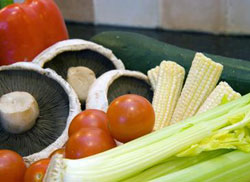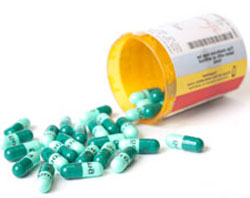Treatment of Chronic Cholecystitis
The first and foremost aim of treatment of chronic cholecystitis is the reduction of the inflammatory process, normalization of the bile secretion, concentration, and excretion, and prevention of gallstone formation.
Diet
 Proper diet plays a key role in the treatment of chronic cholecystitis. First of all, the person with chronic cholecystitis should have at least 5-6 meals evenly spaced throughout the day. Eating small meals at the same time every day normalizes the secretion of bile, promotes easier passage of bile into the duodenum, and prevents cholestasis (a condition during which the bile cannot freely flow from liver to duodenum). On the other hand, if the patient has one big meal, the muscles of the gallbladder and bile ducts might spasm which can cause biliary colic.
Proper diet plays a key role in the treatment of chronic cholecystitis. First of all, the person with chronic cholecystitis should have at least 5-6 meals evenly spaced throughout the day. Eating small meals at the same time every day normalizes the secretion of bile, promotes easier passage of bile into the duodenum, and prevents cholestasis (a condition during which the bile cannot freely flow from liver to duodenum). On the other hand, if the patient has one big meal, the muscles of the gallbladder and bile ducts might spasm which can cause biliary colic.
As a result of the inflammatory process within the gallbladder the pH of bile becomes more acidic, which causes crystals of cholesterol to form within the gallbladder. This causes the bile to have a higher concentration of cholesterol and a lower concentration of bile acids. In order to prevent this, the person with chronic cholecystitis should avoid food made from flour, spicy food, meat, fish, brains, etc. Otherwise, this can cause gallstones to appear or to enlarge the already existing ones.
The amount of protein within the diet of the patient with chronic cholecystitis should be roughly 80-90 grams per day. Products that have a lot of protein and cause the bile to become more alkaline (which is a good thing) are milk, cheese, curt, yogurt, etc. It is important to note that a prolonged diet with a small amount of proteins can lead to the fatty liver dystrophy, impairing its ability to repair and regenerate, and to produce various hormones and enzymes. Thus, avoiding proteins can be detrimental to the patient’s condition.
Fats promote the secretion of bile and the majority of patient should not restrict their intake. However, animal fats are rich in cholesterol and should be restricted. If an insufficient amount of bile enters the small intestine, the fats cannot be emulsified which causes the fats to irritate the walls of the small intestine, causing diarrhea. Studies have shown that a diet with an increased amount of vegetable oils improves the condition of the patient by normalizing the proportion of cholesterol and bile acids within the bile, improving bile secretion and excretion. The proportion of animal fats and vegetable oils within the diet should be 1 to 1. Moreover, vegetable oils such as corn oil, sunflower oil, and olive oil have a large amount of unsaturated fats that promote better metabolism of cholesterol and improve the motor function of the gallbladder. Fats also increase the amount of fat-soluble vitamins, especially vitamin A.
Carbohydrates with a large glycemic index (over 70), including sugar, glucose, honey, jams, etc., should be restricted, especially if the person has a body mass index over 25. Having a large amount of simple carbs within the diet can also stimulate lipogenesis (creation of fat), which can promote the creation of gallstones. The diet should be rich in fibers, which prevents constipation, lowers the glycemic index of carbohydrates, and promotes the excretion of bile from the gallbladder. The diet should include carrots, pumpkins, melons, watermelons, grapes, and additional fiber supplements. The amount of carbohydrates consumed per day during the first week after the flare-up of the chronic cholecystitis should be 250-300 grams. After the first week the amount of carbs can be increased to 350 grams per day. No more than 50 grams of simple carbohydrates should be consumed per day.
Overall, the calorie intake during the first week after the flare-up of chronic cholecystitis should be about 2000 calories per day. After the first week it can be increased to 2500 calories/day.
Consuming the right amount of vitamins is also an important part of the diet of a person with chronic cholecystitis. The diet should include lipotropic products including oats and buckwheat porridge, cheese, codfish, and soy. The way the food is cooked is also very important. During the flare-up of the chronic cholecystitis, all the food should only be boiled or steam-cooked. When the person is in remission the main guidelines for the diet are: restriction of cholesterol-rich foods, spicy food, pickled vegetables and meats, smoked and fried food. The total calorie intake should be about 2500 calories (90 grams of protein, 85 grams of fat, and 350 grams of carbohydrates).
Drug therapy
 Just like the diet, the main aim of drug therapy is the reduction of inflammation.
Just like the diet, the main aim of drug therapy is the reduction of inflammation.
Antibiotics are used in order to suppress the infection located in the bile ducts. The antibiotics are chosen depending on the susceptibility of bacteria. The most commonly used antibiotics for this purpose are fluoroquinolones, macrolides, semisynthetic tetracyclines, and semisynthetic penicillines. In severe cases cephalosporins can be used. All there antibiotics are usually taken orally for a period of 7-8 days. If the infection wasn’t obliterated, the course of antibiotics can be repeated after 3-4 days using a different type of antibiotic. If the bacteria within the bile ducts are not susceptible to any antibiotics listed above (or if the person is allergic to all those antibiotics), trimethoprim can be used. The efficiency of trimethoprim, however, is much lower than of antibiotics, while its damaging effects on liver are more significant.
If the pain caused by the flare-up of chronic cholecystitis is severe, spasmolytics can be used. Spasmolytics relax the sphincter of Oddi and the Lutken’s sphincter, allowing for the bile to flow freely. Spasmolytics are usually used for a period of 2-3 weeks. After that the course can be repeated.
In order to reduce the pain associated with chronic cholecystitis a number of other drugs can be used which includes antidepressants, 5-HT3 antagonists, agonists of к-opioid receptors, and synthetic somatostatins.
Hypotonic biliary dyskinesia can be treated using prokinetics for the period of 10-14 days.
